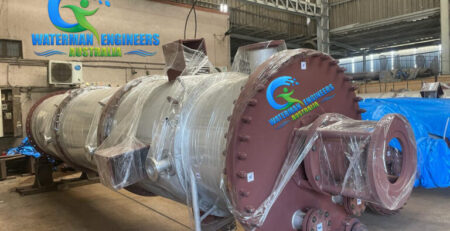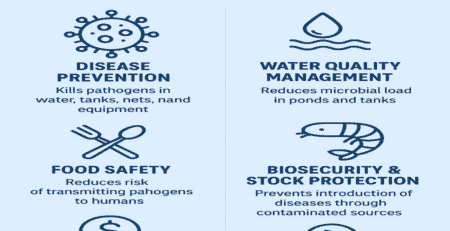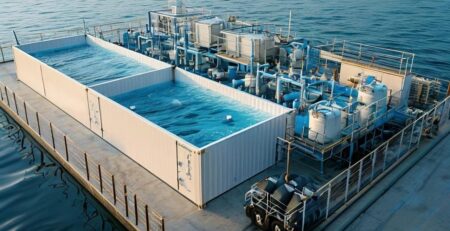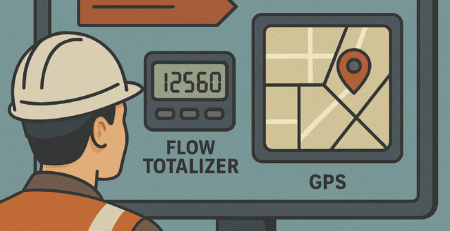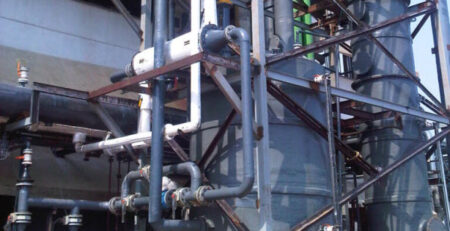Microplastic Pollution and Its Treatment of Marine Environment
Overview:
Microplastics are known as a synthetic organic polymer that are 5mm in size. The products we use daily contain microplastics therefore they have become a huge threat to the environment and are causing a lot of concerns. Microplastics are commonly found in cosmetics, toothpaste, lotions, soaps, body scrubs, facial scrubs, etc. microplastics contained in cosmetics and personal care products are of more concern as they are directly rinsed into the drain and don’t go through precautionary recycling measures. In recent publications, the main source of microplastic pollution in the aquatic system was pointed out to be wastewater treatment plants. Plastic found in the oceans and great lakes is the most prevalent type of marine debris. Plastic materials have become a global concern due to their increased production and lack of proper disposal systems. Annually about 0,48 to 1.27 million tons of plastic waste enter the ocean and it is suspected that this number will double in the future. Microplastics are used in daily essential products due to their stable carbon-hydrogen bonds but this stability makes them resistant to disintegration and therefore they stay in the environment for a long time.
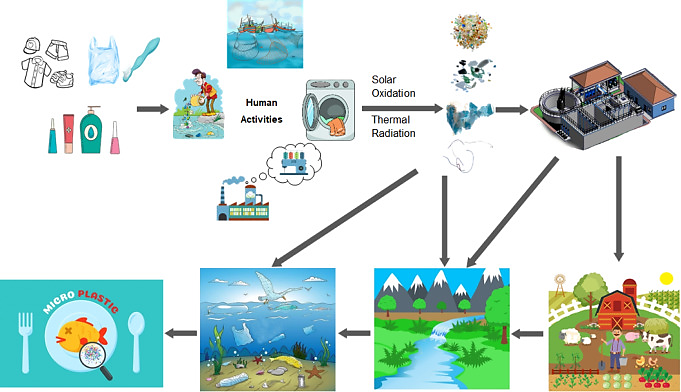
Categories:
Microplastics can be divided into two categories:
- Primary microplastic
- Secondary microplastic
Primary microplastic: Primary microplastic is the microplastic that is manufactured in particles that are micro-sized such as microbeads. They are most used commercially. They are used in cosmetics, clothing, and another textile such as fishnets. The three most used primary microplastics are microbeads, plastic pellets, and plastic fibres. Microbeads are used in cosmetics whereas plastic fibres are used in synthetic textile and plastic pellets are used in industrial manufacturing.
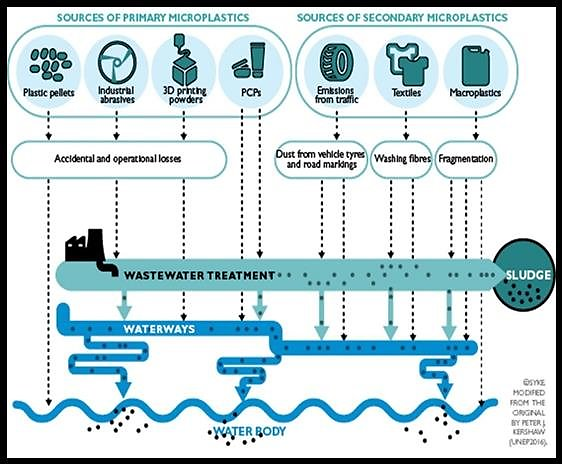
Secondary microplastics: Secondary microplastics are the plastics that result when large plastic items break down like plastic water bottles, plastic bags, fishnets, etc. This breakdown of plastic occurs due to its exposure to environmental factors like radiation from the sun or ocean waves.
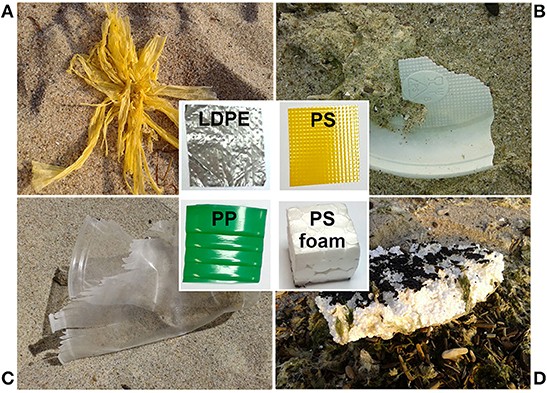
Characteristics of microplastics:
Physical properties of microplastics: Physical properties of plastics like size, density, color, shape, and crystallinity are determined with the help of a microscope. These properties influence the impact of microplastics on the environment and also determine the harmful impact they might have on the environment. Microplastic is solid particles that are composed of high polymer content, are smaller than 5mm, insoluble in water, and are non-degradable. Depending on the type of polymer and the production process, the density of microplastics varies. Microplastics with a density less than water tend to either float on the surface or are suspended in water, where they can be ingested by organisms that live in the water and middle water level. Microplastics vary in color depending on their source, they can be found in pink, red, yellow, transparent, blue, green, brown, black, purple, grey, and white colors. The resistance time and degradation degree of the microplastics in the environment can be determined by their color. Microplastics are found in various shapes like films, foam, sponges, pellets, beads, fragments, fibres, and flakes. The crystallinity of microplastics ranges from 30% to 85%.
Chemical properties of microplastics: Chemical properties of microplastics consist of:
- Chemical composition
- Surface groups
Polymers, additives like antioxidants, plasticizers etc., dyes, and pollutants are adsorbed onto the surface of micropollutants. These chemicals hurt the environment as they are released into the environment during the production, usage, and weathering of plastics.
Sources:
Personal care products: microbeads are used in cosmetics and several personal care products. These microplastics act as sorbents and exfoliators. Studies show that toothpaste contains about 0.1-0.4% microbeads, facial scrubs 1.6-3%, and shower gel 0.5-3%.
Blasting abrasives and cleaning products: Microplastics are used as abrasives for cleaning surfaces. Blast media consist of polyester, polycarbonate, or polyamide. They are also used in marine industries as cleaning agents to clean tanks.
Synthetic textile and tires: Scraping and dispersion of fibres during the process of laundry in household and industries produce a large number of primary microplastics that goes into sewage water and culminates in the ocean.
Paint and wood preservatives: Primary microplastics are added to paints and preservatives.
Synthetic waxes and oil gas industry: Synthetic waxes used in dyeing, food coating, lubricants, and coating of papers contain primary microplastics.
Packaging material: Packaging material is responsible for 62% of plastic waste.
Medical resources: Microplastics are also used in the field of medicine.
Pathway of microplastics:
Microplastics can enter the environment either through a direct route or an indirect route. In the indirect entry, route microplastics enter the ecosystem by breaking down into smaller and smaller components due to either UV radiation or by mechanical effects. Their rate of distribution in water, air, and solid depend on their composition. Microplastics can enter the ecosystem directly by tire abrasion, synthetic textile fibres released during the washing of clothes, and also through care products like peelings containing microplastics. Another major source is industrial wastewater. A high level of contamination occurs due to inadequate waste management, sewage treatment plants, or the plastics industry. Transport processes like wind, currents, water, ebb, and flow, and surface runoff from rain influence microplastic contamination.
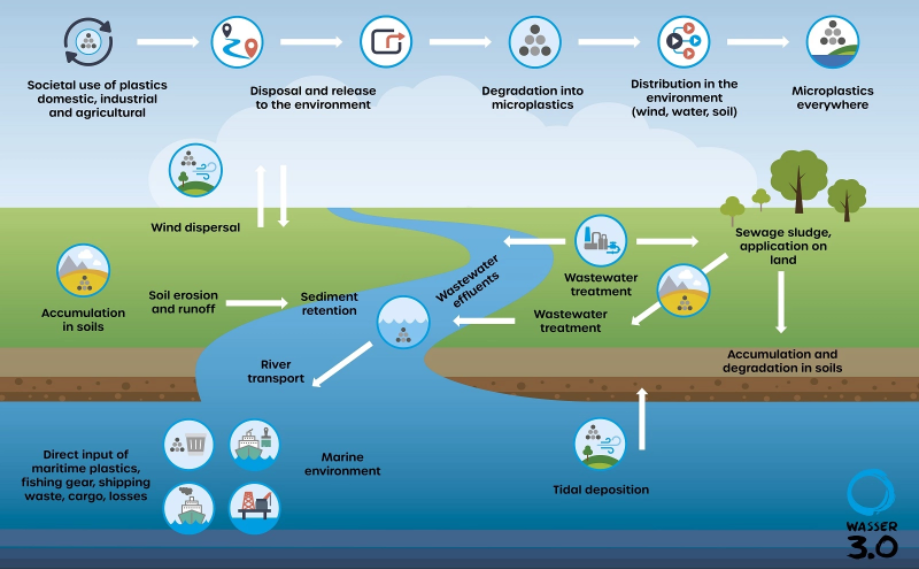
Impact on the marine ecosystem:
Marine organisms can get entangles in plastic wires of nets moreover microplastics can be ingested by fishes, turtles, benthic invertebrates, birds, mammals, and turtles. The ingestion of micropollutants can affect the immune system and can both chemically and physically block digestive organs and can prevent the organisms from feeding. Microplastics can delay growth, result in reproductive toxicity, reduce food intake, and can also cause oxidative damage and abnormal behavior. These microplastics can also penetrate the biological barrier and accumulate in the tissues, this can result in ROS generation that can have an impact on lipid metabolism.
Inhibit growth and development: Microplastics have harmful effects on the growth and development of marine life. Polystyrene microplastics n the sediments can negatively impact the growth and development of the Arenicola marina. These microplastics accumulate in the digestive tract of marine life and block it, this causes satiety and cause a decline in feeding capacity. Due to things `energy reserves in the body decrease and growth is affected.
Toxicological effects: Microplastics can also impact the reproductive system of marine life. Polystyrene microplastics can reduce the number of eggs ovulated by the Crassostrea Gigas. Microplastics can also reduce sperm motility levels and inhibit the reproductive capacity of the Crassostrea Gigas. Microplastics can also trigger a series of immune responses like microplastics like polyvinyl chloride and polyethylene can cause oxidative damage to the white blood cells of Sparus aurata and dicentrarchus labrax and result in immunotoxicity.
Table 1: Toxicological effects of microplastics on fish
| Fish species | Microplastic type | Particle size | Concentration | Toxicological effects |
| Pomatoshistos microps | PE | 1~5μm | 184μg/L | AChE activity decrease |
| Acanthochormis Polyacanathus | PET | 1~2mm | 0~0.86mg/L | Growth decrease |
| Dictrarchus labrax | PE | 10~45μm | 10~100pcs/mg | Mortality increase |
| Dictrarchus labrax | PVC | <0.3mm | 0.1% (quality ratio) | Inflammation |
| Dictrarchus labrax | Polymer | 1~5μm | 0.69mg/L | Swimming speed decrease |
| Oryzias Lapites | PE | <1mm | 8μg/L | Male: the abnormal proliferation of sperm cells |
| Carrassius Carassius | PS | (24.7±0.2) nm | 130mg | Vitality decrease
|
| Daniorerio | PS | (24.7±0.2) nm | 1.5×1013pcs/L | Body length decrease |
| Daniorerio | PE, PP, PA, PVC | 70μm | 1.0mg/L | Intestinal injury |
Genetic damage: Microplastic can also cause genetic damage to marine life. Microplastics can cause immunotoxicity, neurotoxicity, and genotoxicity to galloprovincialis and can also cause genetic damage in mussels.
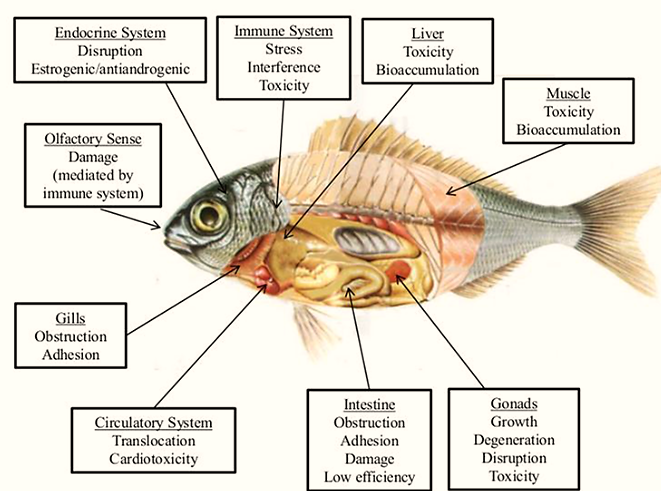
Effect on planktons: Microplastics can cause a reduction in chlorophyll absorption by penetrating the cell walls of phytoplankton. Also, when exposed to microplastics heterotopic plankton undergoes phagocytosis which results in the retention of microplastics in their tissues.
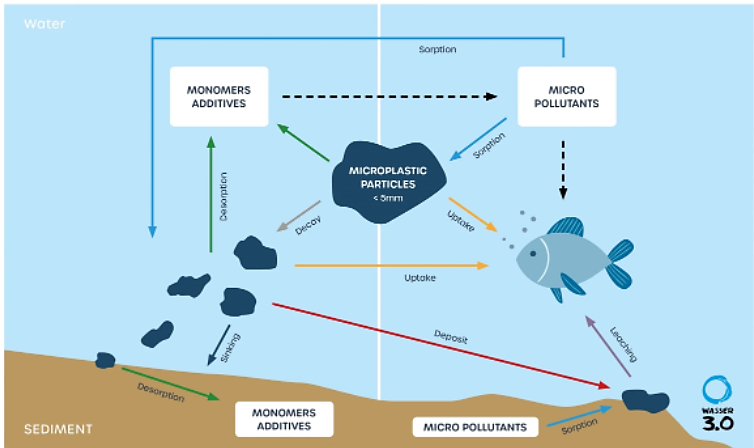
Removal techniques for removal of microplastics:
Conventional wastewater treatment: Wastewater treatment consists of primary, secondary, and tertiary stages. In the primary stage, large floating materials and grits are removed. In the primary treatment stage, insoluble solids from the wastewater streams are removed by physical settling through processes of screening, grit removal, oil and grease removal, and sedimentation. The pollutants that can settle under gravity are removed in this stage. In the second stage attached growth system or suspended growth system is used to remove the biological content of wastewater. Tertiary treatment is the last and final stage in which waste is removed by filtration, chemical disinfection, reverse osmosis, ozonation, etc. sedimentation can remove 1.8% to 54.5% of microplastics. 50%-98% of microplastics are removed in the primary stage. In this stage, microplastics are removed through skimming and settling.
Algal masses: Microalgae can be used to remove microplastics. Microalgae can colonize microparticles and alter the bouncy of the aggregates. This causes differential sedimentation rates as compared to unaggregated particles.
Bioinspired molecules: a combination of organic-inorganic molecular building blocks can facilitate the removal of microplastics. These bioinspired molecules have an inclusion unit and a capture unit which when combined form an inclusion compound. When the microplastic particles are captured in the inclusion compound, the embedded water molecules get displaced. Through Van Der Waals forces the displaced water molecules combine with the surrounding water molecules. The displaced water molecules create a cavity that gets filled with the microplastics, hence removing them from water.
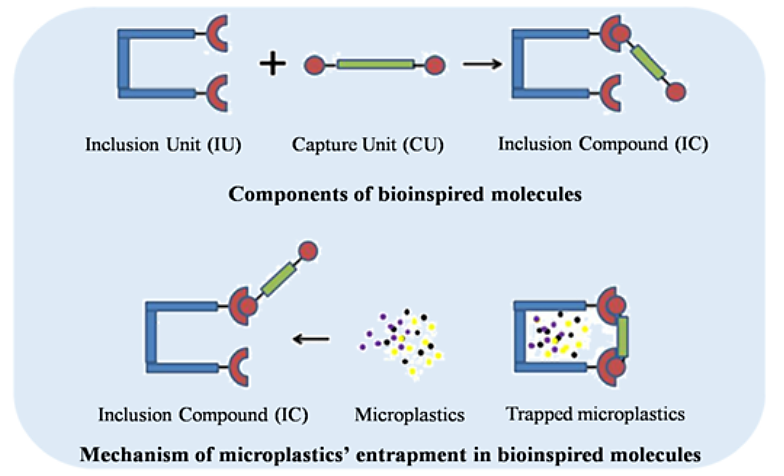
Metal-organic framework-based foam: These are combinations of metals and organic ligands and are porous structures. They are reliable in entrapping pollutants as they are porous and have a high surface area and versatile functionality.
Future recommendations:
Microplastic pollution can be reduced by using clothes made from natural products. A filter can also be installed in the machine that can capture the microplastics. The use of single-use plastic should be reduced. As car tired are also a source of microplastic pollution, public transport should be used to reduce the consumption of tires. Plastic-free costmaries should be used.
Microplastic Pollution Frequently Asked Questions
1) What is marine Micro plastic pollution?
Most plastic waste in the ocean disintegrates into incredibly tiny particles. “Micro plastics” are these tiny pieces of plastic. Other polymers are purposefully made to be tiny. They go by the name of micro beads and are found in plenty of cosmetic and wellness goods. They enter the ocean unaltered through waterways.
2) How micro plastics affect the marine environment?
The marine fish and marine food chain will be impacted in many different ways by marine micro plastics. The micro plastics may reduce food intake, impede growth, result in oxidative damage, and cause aberrant behavior in fish and other aquatic species.
3) How can we reduce micro plastics in the ocean?
Here are seven ways you can make a difference, starting today.
- Reduce Your Use of Single-Use Plastics
- Support Legislation to Curb Plastic Production and Waste
- Recycle Properly
- Participate In (or organize) a Beach or River Clean-up
- Avoid Products Containing Microbeads
- Spread the Word
4) Where does micro plastic pollution come from?
Textiles, tyres, and city dust-the primary sources of micro plastic contamination-contain almost 80% of the micro plastic found in the environment. Investigations into the aquatic environment are widely utilized to verify the presence of micro plastics in the ecosystem.
5) How are we removing micro plastics from the ocean?
The traditional method of removing micro plastics from water is filtration, but this is time-consuming and expensive.

